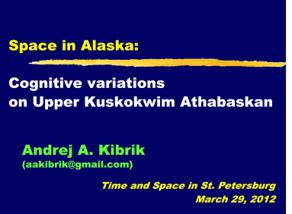A. Kibrik: Upper Kuskokwim Athabaskan grammar
Upper Kuskokwim is spoken in central Alaska, primarily in the villages of Nikolai and Telida. There are 15 speakers out of a total population of 90 individuals. It was not recognized as a language separate from "Ingalik" until Michael Krauss's visit in 1962. At that same visit, Krauss also noted that the language was spoken by children. Since that time, the language languished because it was no longer used on a daily basis by village members with the exception of two or three couples.
In the 1960s and 1970s useful work was completed by Raymond Collins of the Summer Institute of Linguistics and the Upper Kuskokwim language specialist, Betty Petruska. Their work together produced a "junior" dictionary and a grammatical sketch of the language.
Andrei Kibrik is writing a full grammar of Upper Kuskokwim, the first of any Athabaskan language in Alaska. Upon receiving a Fullbright scholarship in 1997, Kibrik made his first trip from Moscow to study Upper Kuskokwim. During his stay of three months, he documented the language with a narrow focus on grammar and lexicon and most importantly, established friendships within the community. Later in 2001, support from the Max Planck Institute for evolutionary anthropology allowed Kibrik to return to Nikolai. Kibrik continued gathering grammatical, lexical and textural data, but not sufficent for comprehensive documentation.
As of the fall of 2010, Kibrik has spent 2 more field seasons in Nikolai and a visit to Telida gathering additional data to accomplish the task.
Michael Krauss notes, "Kibrik will also bring to it (Upper Kuskokwim) many useful approaches not generally considered by Americans in Athabaskan study."
As of fall 2011, Kibrik writes that he has been, "working towards the final goal of the project, that is a grammatical description of Upper Kuskokwim."
Kibrik lists activities accomplished in 2010-2011 bringing him closer to the final goal:
- New texts in Upper Kuskokwim are captured, utilizing "natural dialogue," that he notes
were, "previously undocumented."
- The recording 4 different speakers commenting on a filmed hunting trip in the local area. Kibrik states this is considered a "novel stimulus for discourse production."
- The recorded speech discourse was "transcribed and glossed to produce a data set."
- Dialect differentiations of these Upper Kuskokwin speakers are mapped out.
Early November 2011, Kibrik sent the PI a draft table of contents of over 80- chapters.A draft chapter on morphology, syntax, and semantics of possessive constructions was included. KIbrik predicted the descriptions of Upper Kuskokwin speech discourse could add another 2000 pages when completed.

Mid-May 2012, Kibrik promised a draft copy of the UK grammar by September 2012. He admits it would be far from a complete description of the grammar but it will provide a concise account of the many chapters he drafted in November 2011. Kibrik mentions a phonetician researching the UK prosody. Research included tone suspect words pronounced differently by 5 different speakers analyzed for any kind systematic differences between constricted and non-contricted syllables.
Kibrik's final fieldtrip was September 2012 to the Telida area for data collecting relating to the discourse patterns of UK. As mentioned earlier, Kibrik researched UKA prosody with the assistance of a phonetician. Russian phonetician and typoligist Sandro V. Kodzasov sees no indication of tone in the language.
As promised, Kibrik sent a draft description of the UK grammar and texts during fall 2012. It was over 1000 pages long. Linguistic material with examples is included. This is to be released at a later date.
Other presentations Kibrik has presented.
Prosody and local discourse structure in a polysynthetic language
Qualitative morphological complexity: The Case of Athabaskan
Native Periphery of Russian America: Upper Kuskokwim Athabaskans


